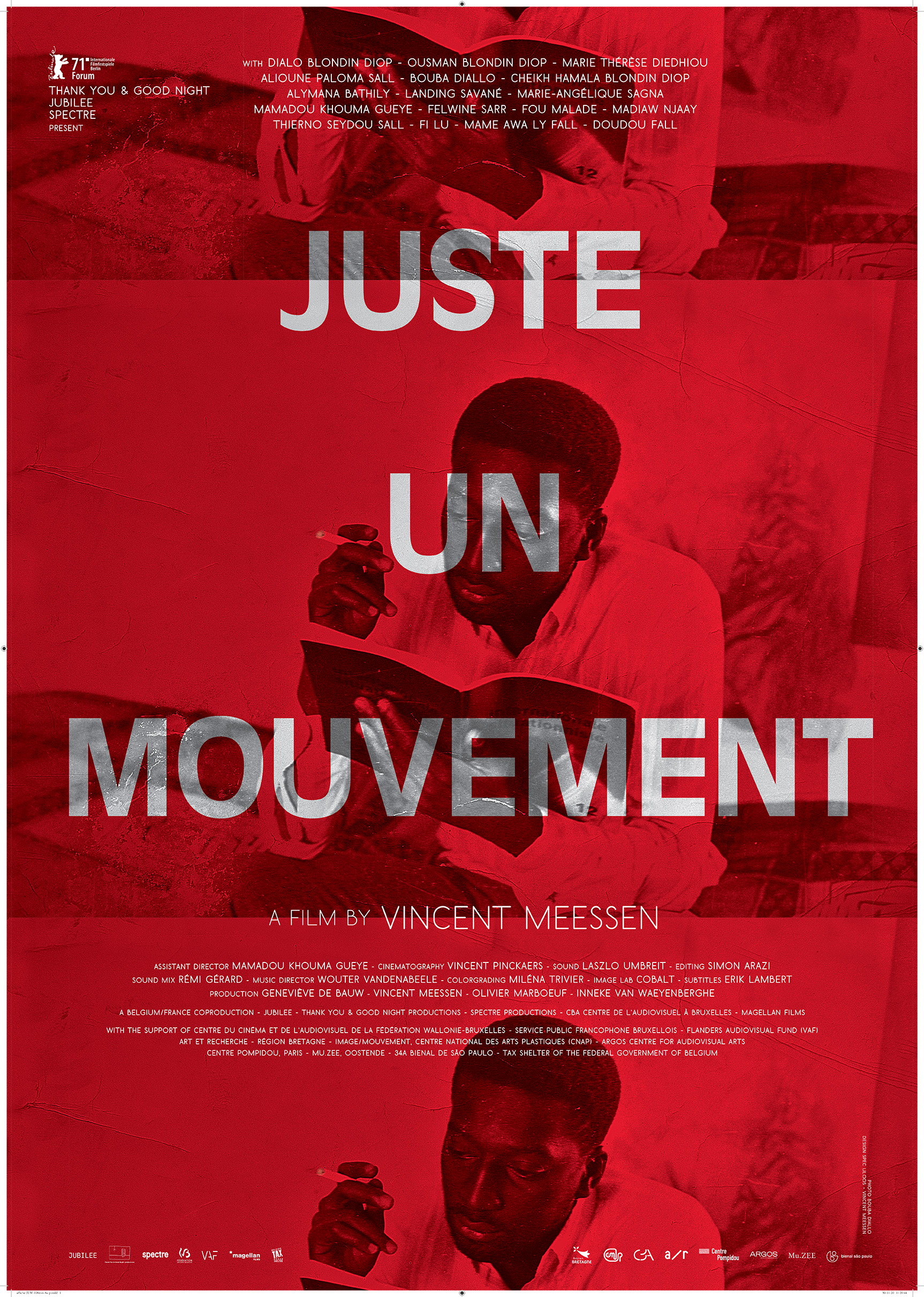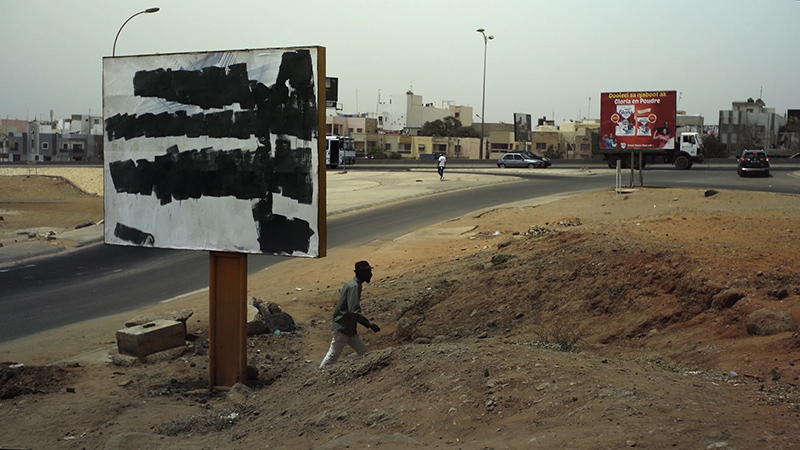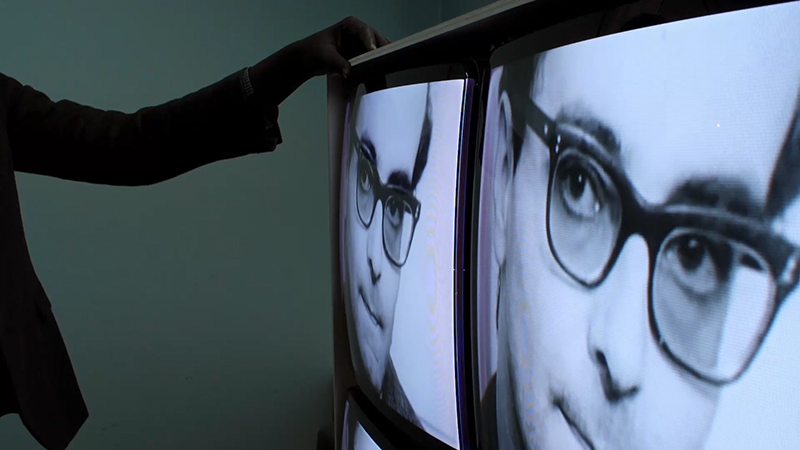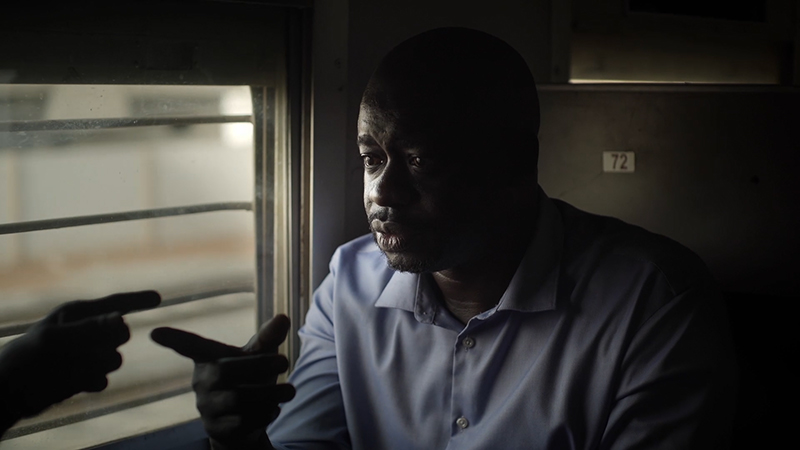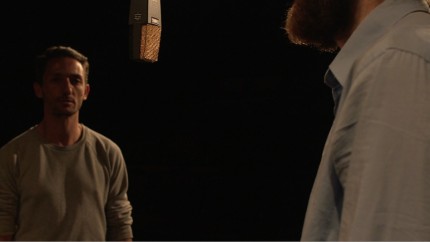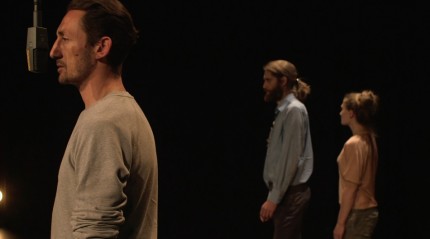Juste un Mouvement
A film by Vincent Meessen
“Omar is dead!”, a voice cried out in Dakar, 11 May 1973. The eldest of the Blondin Diop family, a young militant philosopher, and the articulate Maoist in Jean-Luc Godard’s La Chinoise had allegedly committed suicide in his Gorée Island prison cell. His family and friends did not believe a word of it, demanding that light be shed on this political crime. A phantom haunts the Senegalese capital, itself in a state of unrest.
Juste un Mouvement is a free take on La Chinoise, a Jean-Luc Godard movie shot in 1967 in Paris. Reallocating its roles and characters fifty years later in Dakar, and updating its plot, this new version offers a meditation on the relationship between politics, justice and memory. Although not anymore alive, Omar Blondin Diop, the only actual Maoist student in the original movie, now becomes the key character.
Shot exclusively with non-professional actors and including Omar Blondin Diop’s brothers and friends, everyone in this film performs themselves: a filmmaker, a rapper, a poet, a Chinese worker, a Shaolin master, a Senegalese intellectual, the Minister of Culture of Senegal and the Vice President of the People’s Republic of China.
Single-channel HD Video, 108 min, sound & colour, Belgium-France, 2021
Status: World premiere at the 51st Berlinale Forum, 01/03 – 05/03/2021
For a full overview of past and future festivals and other screenings, see here
Cast: Alymana Bathily,Cheikh Hamala Blondin Diop, Dialo Blondin Diop, Ousman Blondin Diop, Bouba Diallo, Marie Thérèse Diedhiou, Felwine Sarr, Alioune Paloma Sall , Landing Savané, Marie-Angélique Sagna, Mame Awa Ly Fall, Doudou Fall, Mamadou Khouma Gueye, Fi Lu, Mbagnick Ndiaye, Madiaw Njaay,Thierno Seydou Sall, Malal Almamy Tall (Fou Malade), Li Yuanchao.
Director: Vincent Meessen
Assistant director: Mamadou Khouma Gueye
Director of photography: Vincent Pinckaers
Assistant camera: Artur Castro Freire
Sound engineer: Laszlo Umbreit
Editing: Simon Arazi
Colourgrading: Miléna Trivier
Image lab: Cobalt
Improvised music: Wouter Vandenabeele, Bao Sissoko
Sound design: Laszlo Umbreit
Sound mixing: Rémi Gérard
Executive production: Vincent Meessen, Inneke Van Waeyenberghe
Production: Jubilee, Thank You & Good Night productions, Spectre Productions, Magellan films
The feature film was co-produced with Thank You & Good Night productions (B), Spectre productions (F) and Magellan films (B) with the support of Centre du Cinéma et de l’Audiovisuel de la Fédération Wallonie-Bruxelles, Flanders Audiovisual Fund, the 34th Bienal de Sao Paulo, Centre Pompidou musée national d’art moderne, Mu.ZEE, Centre Bruxellois de l’Audiovisuel, Région Bretagne, Image/Mouvement-CNAP, Argos centre for audiovisual arts, Art et Recherche and Tax Shelter of the Federal Government of Belgium.
Essays (in English)
Jochen Becker, Arsenal, June 2021
“What makes Meessen’s film so politically unique is how it traces the gradual superseding of Françafrique by Chinafrica.”
Bert Rebhandl, Arsenal, June 2021
“In 2021, as in 1967 or 1973, it remains necessary to clarify how certain struggles can be inscribed into the current geopolitical constellations.”
For an overview with links to all publications about Juste un Mouvement, see here
A Modest Proposal (in a Black Box)
A film by Vermeir & Heiremans
In their film, A Modest Proposal (in a Black Box), Vermeir & Heiremans, who are also the film’s protagonists, discuss a new financial model with a lawyer. Their dialogue, witnessed by the lawyer’s assistant, focuses on the question if financialisation can be repurposed towards generating a more equitable arts ecology.
Considering the financialisation of public art collections, museum real estate and symbolic capital, the financial model should benefit not only investors and art institutions, but also its stakeholders, the creators of the art assets’ value, the artists and art workers.
In the film the artists propose to financialise a specific building as their first case study: Pump House Gallery in Battersea Park. The gallery is located in the vicinity of the Battersea Power Station, a 20th century former coal-fired power station, currently under re-development. It will house Apple’s London headquarters and offers luxury apartments for sale, designed by Frank Gehry and Foster and Partners. All in all an excellent momentum to leverage rising values that surround the gallery, to ‘pump’ up the building’s value as an asset, and generate a return on investment for the wider art community.
The conversation between the artists and the lawyer takes place in Vermeir & Heiremans’ house, which in their practice they define as an art work. Meanwhile the seemingly absent-minded assistant often slips away from the discussions. She appears to be able to materialise and dematerialise at will the lofty space by caressing the walls, playing with the miniature furniture inside a scale model of the artists’ house or using the latter as a framing device, manipulating the window views.
When the artists and the lawyer go on to discuss and celebrate the proposal on the loft’s rooftop garden, glass of champagne in hand, she takes control…
Watch the film on Vimeo: https://vimeo.com/290694804
password: AMP2018
Credits
HD Video, 28′ 7″, sound & colour, UK-Belgium, 2018
Cast:
Vermeir & Heiremans as the artists
Luke Mason as the legal consultant
Heike Langsdorf as the assistant
Directors: Vermeir & Heiremans
Camera: Amir Borenstein
Editors: Katleen vermeir/Amir Borenstein
Sound: Justin Bennett
Organ Player: Cindy Castillo
Voice-over: Emily Rosamond
Script: vermeir & Heiremans/Luke Mason
Graphic design: Salome Schmuki
Animation: Amir Borenstein
Production: Jubilee vzw
With the support of:
The Flemish Community
Art et Recherche asbl
Federation Wallonie-Bruxelles
Pump House Gallery
Wandsworth Council
Enable Leisure and Culture
Art Council England
Cockayne-Grants for the Arts
The London Community Foundation
Presentations to date:
A Modest Proposal – Rethinking Art, Law, and Urban Renewal, film screening and panel discussion at the Kunsten Museum of Modern Art, Aalborg (Denmark, 2020)
Rencontres Internationales Berlin (2019)
11th Critical Finance Studies Conference, lecture and screening at the University of Birmingham (2019)
The art of equity / The equity of art, lecture and book presentation at WIELS Contemporary Art Centre, Brussels (2019)
A Modest Proposal, one-day symposium at the Royal College of Art, London (2018)
A Modest Proposal, a lecture for The Atlantic Project, festival of contemporary art, at the Council House, Plymouth (2018)
A Modest Proposal (in a Black Box), a solo exhibition at Pump House Gallery, London (2018)
A Modest Proposal, a publication by Vermeir & Heiremans (2018)
Reviews and reflections:
Zeynep Kubat, ‘Kop of munt: financiële verbeelding in de kunst‘, in: Rekto:Verso, August 29 2019 (in Dutch)
Dirk De Wit, ‘Naar een wederkerig werken in de kunst‘, in: Boekman Stichting, 2020 (in Dutch)
Selection overview of press, reviews and reflections on Vermeir & Heiremans practice (2009-2020)
Ultramarine
Blue is the chromatic, historical and discursive filter through which a performance by African-American poet Kain unfolds. The famed precursor of hip-hop in the late ’60s delivers his “spoken word” as the Belgian percussionist Lander Gyselinck improvises to the flow of his utterances. Throughout the performance various museum objects — funeral figurines, automaton, astrolabe, mappa mundi, textiles —are juxtaposed to Kain’s own props. They invoke affective retrospections on exile and belonging, slave routes and colonial trade.
“So far, all that has given color to existence still lacks a history“
Friedrich Nietzsche, The Gay Science
Ultramarine, referring to a deep blue pigment but also to overseas regions, is a visual poem constructed from locally chosen historical objects. The project has been commissioned by the Printemps de septembre (Toulouse, France) and will be premiered in September, 2018 in this city historically connected both to ‘pastel’ blue pigment and to the ‘Gay Science’ of the troubadours. As Blues Klair, it is touring Canada with two solo shows: Leonard & Bina Ellen Art Gallery (Concordia University), Montreal, 2018, and The Power Plant, Toronto, 2019-2020.
Disrupting the Eurocentric written logic of historiography as well as that of museum classifications, Ultramarine sets a constellation of objects moving and enable them to expose their intertwined histories. The immersive experience of colour, a living, textured, spectral and polymorphic substance is here rendered inseparable from its political component and from cinema as magical practice. The film is conceived as a kind of “narrated exhibition” featuring Kain The Poet – the afro-american poet and performer, part of the Black Arts Movement (BAM) at the end of the sixties and creator of the mythic 1970 album Blue Guerilla. He colors history through spoken word, alluding to his own exile blues in Amsterdam. The music is improvised by drummer Lander Gyselinck.
Ultramarine is composed like a spectrum: it unfolds and intertwines fragments of meaning. This narrative form creates the possibility of connecting Kain’s poetic to a larger frame of investigation: museum objects and artworks stored in various Toulouse museums and in collections of the Occitan region. These objects, connected with the double sense of ‘ultramarine’ (both a color and a colonial reference) are put in dialogue with stage props and reproductions of art works that surround Kain in his Amsterdam exile since the 1980s.
Like the shifting layers of blue in the film’s 35 mm cinematic image, as well as the surround soundscape, the exhibition display – a modular textile display designed in collaboration with textile designer Diane Steverlynck and scenographer Emilie Lecouturier – offers an immersive experience to the visitor.
Film credits
HD Video, 42′, 35mm, sound & colour, 2018
Directed & produced by Vincent Meessen
Jesus Wept (The Journey of K)
Abridged version, written and performed by Kain The Poet
Music improvised by Lander Gyselinck
With guest appearances by:
Dirk DeJonghe
Serge Nicolo & Germain Berdie
Noémi Panguiangani
Malek Terkemani
Valérie Alingrin
Gea Russell
Executive producer: Inneke Van Waeyenberghe
Director of photography: Vincent Pinckaers
Sound recording: Laszlo Umbreit, Rémi Gérard, Frédéric Alstadt
Image editing: Inneke Van Waeyenberghe
Sound editing: Laszlo Umbreit
Sound mixing: Rémi Gérard
Color grading: Miléna Trivier
Textile Installation: Diane Steverlynck in collaboration with Émilie Lecouturier
First camera assistant: Artur Castro Freire
Second camera assistant: Lucy Mallet-Jemmings
Subtitles: Erik Lambert
Credits: Speculoos
Typefaces: Titra, Belgika
Produced by Jubilee, in collaboration with:
Le Printemps de septembre, Toulouse
Leonard & Bina Ellen Art Gallery, Concordia University, Montreal
The Power Plant Contemporary Art Gallery, Toronto
With the support from:
Vlaams Audiovisueel Fonds (VAF)
Vlaamse Gemeenschap
Nouveau Musée National de Monaco
Awards:
Dialogue Award at the European Media Art Forum (EMAF), Osnabrück 2019
The jury called Ultramarine a “powerful and complex constellation of different positions, references and contexts that unfold in a variety of ways – as performance, music, poetry, text, museum and archive. Vincent Meessen explores the interweaving of social and aesthetic interests, transcending the boundaries of various artistic practices. The work combines history and culture to give a voice to the visible and the invisible”.
Ammodo Tiger Short Award at the International Film Festival Rotterdam 2019
“Rarely has the relevance of film to performance been so clear. The role of cinema here stunningly enforces the rhythm, vision, and urgency of the poet’s delivery. The film is precisely structured in a way that allows us to see the images the poet conjures, to sonorise the beat at which he speaks and to feel what is so radical in his utterance. The jury was utterly convinced.”
Members of the jury: Nguyen Trinh Thi, John Canciani, Lawrence Abu Hamdan
presentations to date:
Blues Klair, solo exhibition by Vincent Meessen at The Power Plant, Toronto (2019-2020)
The Image and Its Image, a series of screenings curated by George Clark for the annual NFKS Film Festival, Kabelvåg (Norway, 2019)
FID 2019, 30th International Film Festival Marseille (2019)
An evening of Award-Winning Films from EMAF 2019, Kunsthalle Osnabrück (Germany, 2019)
Unfolding the Past, International Competition Videoex Festival, Zurich (2019)
European Media Art Festival (EMAF) No. 32, Osnabrück (Germany, 2019)
Courtisane Festival 2019, Ghent (2019)
IFFR – International Film Festival Rotterdam (2019)
Blues Klair, solo exhibition at Leonard & Bina Ellen Art Gallery, Montreal (2018)
12th Shanghai Biennale, curated by Cuauhtémoc Medina (2018)
Read more on Ultramarine at Printemps de septembre (21/09 – 21/10/2018) here
Read more on the exhibition Blues Klair at Leonard & Bina Ellen Art Gallery (17/11/2018 – 23/02/2019) here
Read more on the exhibition Blues Klair at The Power Plant (21/09/2019 – 05/01/2020) here
Vilgiskoddeoayvinyarvi: Wolf Lake on the Mountains
We follow Viktor Koslovsky, a scientist still working at the otherwise abandoned Kola Super-Deep Borehole, a geological research station “at the border of everything” in north-west Russia. He tells of the history of this former cold-war project and of his current research which he describes as “listening to the past in order to hear the future”.
The Kola Super-Deep Borehole (KSD) is the deepest man-made hole on earth – more than 12 km deep. It was a Soviet geology research project started during the Cold War. In addition to gathering data about the geology of the earth’s crust it formed part of Project Globus, a network of seismic listening stations which was to act as an early-warning system for natural disasters as well as for monitoring enemy nuclear tests. After the fall of the Soviet Union the project was slowly wound up and the site was abandoned in 2008.
The rock strata that are visible in the core samples extracted from the borehole are seemingly inert to humans but on another time-scale they are very much alive. They tell the story of the formation of the earth and of ultra-slow processes that are still taking place within the earth’s crust. Thinking at this geological timescale puts human endeavour and progress into perspective, the Kola Super Deep becomes merely a pin-prick into the body of the earth.
Still, the image of drilling so deep into the earth inflamed the imagination of evangelical Christians with an image of Hell. The sounds of screams emanating from the inferno circulated on the internet purporting to have been recorded by the Russian scientists – probably a montage of horror-film soundtracks. The layers of rock penetrated by the drill resound with Dante’s decent into the Inferno with Virgil as his guide – where each layer or circle of Hell is reserved for different kinds of sinners, each with their own story. In which circle of Hell can the conspiracy theorists be found? Which is reserved for the climate change deniers?
At the KSD site, next to Wolf Lake, we meet Viktor, a geologist who worked on the project until it was shut down. Ever since, Viktor has stayed on-site as much as possible, carrying on the work started by Dr. Huberman, the founder of the project. He recounts the history of the KSD, relating it to other cold-war science projects, about the geology and history of the area, and of his experiences living there alone. He guides us around the ruined site, introducing his living quarters, his small laboratory and of course the borehole itself. He explains his work, listening to vibrations deep within the earth, linking geology with Sami shamanism and divination.
The Vilgiskoddeoayvinyarvi: Wolf Lake on the Mountains project began during a residency of the art and research project Dark Ecology in Norway and Russia in 2015. In June 2016, during the third edition of Dark Ecology it was presented as a site-specific audio walk in Russian and English, where the audience visited the KSD site itself with my piece acting as an audio guide. The footage to be used in the final film, along with extra sound recordings, was shot during the final production process in Russia. The images were shot in HD with a DSLR. The audio techniques are diverse, including binaural and surround (ambisonic) recordings. A three channel audio visual installation of it was shown at the 2017 Sonic Acts festival in Amsterdam. In 2018, a new version of it was presented at Artefact 2018 in Leuven, with drawings, charts, and historical photographic material alongside the video images and sounds. A single screen film (25 min.) will be shown around the world.
Production: Justin Bennett and Jubilee
Commissioned by Dark Ecology and Sonic Acts
Supported by STUK and Mondrian Fund
Presentations to date:
Rencontres Internationales Paris/Berlin festival of moving image; Paris (2019)
Science of Sound, group exhibition at at Dordtyart, Dordrecht (2018)
Geological Imagination, duo exhibition with Cecilia Jonsson at Terminal B, Kirkenes (NO, 2018)
SOUNDS LIKE SILENCE, talk/ screening during the release party of O, Wonder! #2 at Compagnie Theater, Amsterdam (2018)
Artefact Festival 2018, This Rare Earth – Stories From Below, audiovisual installation at Artefact Festival in STUK, Leuven (2018)
SALT ART: Selected from Dark Ecology, Sauna Session and screening at SALT Árdna, Oslo (2018)
Inversia Festival, Murmansk (RU, 2018)
The Noise of Being, a group exhibition at Arti et Amicitiae for Sonic Acts Festival, Amsterdam (2017)
A like-named site-specific audio work, which preceded the film, was presented during Dark Ecology, the third edition of the art, research and commissioning project in the border zone between Norway and Russia (2016)
Yar bana bir eğlence. Notes on Parrhesia
A film by Eleni Kamma
In her first cinematographic film, artist Eleni Kamma revisits the tradition of the Karagöz Theatre and its role in the creation of a political voice.
Although Karagöz is a local character symbolizing the ‘little man’ within the limits of the Ottoman Empire, he belongs to a larger puppet theatre family. He speaks of what the people want to hear and what the people want to say.
Until 1870, despite the “absolute monarchy and a totalitarian regime”, Karagöz “defied the censorship, enjoying an unlimited freedom”.Through the use of empty phrases, the illogical, the surrealistic, extreme obscenity and repetition, Karagöz theatre was often used as a political weapon to criticise local political and social abuse.
By 1923, this multi-voiced empire gave way to a Turkish-speaking republic within which the caricatures of ethnic characters no longer made sense. With the rise of new media, the popularity of Karagöz and Orta Oyunu declined even further.
Yar bana bir eğlence. Notes on Parrhesia reflects upon the term ‘parrhesia’, which implies not only freedom of speech, but also the obligation to speak the truth for the common good, even at personal risk, by questioning how the notion of entertainment relates to personal expression and public participation.
This is where the artist links to the Gezi Park protests in 2013, in which humor and creativity were key elements in mocking the political regimes. Filmic fragments from National Cypriot television archive alternate with the voices of Cypriot, Greek and Turkish Karagoz masters discussing the language, the history, the tools, and the political role of the medium.
The film is a visual essay in which pressing contemporary political matters intertwine with history and abstraction, and in which meticulousness of research meets with poetics of associations. How to move forward? Can we learn something from the old masters? At times the gaze is directed back to the viewer. To speak your mind, you must first overcome fear by taking a deep breath.
Credits
Single channel, HD Video, 37′ 24″, sound & colour, 2015
Written, directed and produced by Eleni Kamma
With the voices of:
Alize Garip
Barış Mumyakmaz
Ilgın Deniz Akseloğlu
Kardeş Türküler
Emin Şenyer
Tacettin Dikker
Cengiz Özek
Yannis Kissonergis
Panos Panagiotopoulos
Mavilli Collective
Christodoulos Antoniou Pafios
Anna Maragou
Thodoris Kostidakis
Euripides Dikaios
Takis Hadjittofis
Athos Danellis
Uygar Çehreli
Gani Ömür Çekem
Samet Kesen
Performers:
Adaline Anobile
Jaime Vicente Liopis Segarra
Michiel Reynaert
Master craftsmen and shadow puppeteers in action:
Emin Şenyer
Yannis Kissonergis
Choreography advisor: Michiel Reynaert
Camera: Boris Van Hoof
Specific footage credits:
Andreas Haralambous (Panel discussion, NIMAC, Cyprus)
Ilgin Deniz Akseloğlu & Ferhat Tokmak (Interviews with Gezi protesters, Istanbul)
Jessica Van Rüschen (First assistant, grip, dolly operator, Maastricht)
Gezi Park still images: Eleni Kamma
Props design and realization:
Ron Bernstein, Heimo Lab, Van Eyck, Maastricht
Stage lighting design: Paul van Laak
Editing: Inneke Van Waeyenberghe
Sound:
Boris van Hoof, Andreas Haralambous, Ilgin Deniz, Akseloğlu & Ferhat Tokmak,
Jessica van Rüschen
Sound design and mix: Laszlo Umbreit
Script montage and editing: Tina van Baren
Colourgrading and mastering: Paul Millot, Cobalt Films
Post production supervision: Inneke Van Waeyenberghe
Graphic design: Maaike Beuten, Garage 64
Silkscreen fabrics:
Margriet Thissen, Charles Nypels Lab, Van Eyck, Maastricht
Prints on paper: QS Graphics, Maastricht
Filmed at:
Istanbul Military Museum; NIMAC Nicosia Municipal Arts Centre; Karagöz Museum, Bursa; Gezi Park, Istanbul; Cihangir Park, Istanbul; Theater aan het Vrijthof, Maastricht; Halkalı Kultur Merkezi, Küçükçekmece, Istanbul; Zappeion Greek School, Istanbul; Avcilar Cultural Center, Istanbul; Emin Şenyer’s studio, Avcilar Istanbul
In co-production with Jubilee and Netwerk centre for contemporary Art Aalst
With the support of:
The Mondrian Fund, NiMAC (Nicosia Municipal Arts Center), PiST/// Istanbul, SoundImageCulture (SIC), the Theater aan het Vrijthof, Maastricht, VAF (Flanders Audiovisual Fund), and Jubilee
Presentations to date:
Jubilee at Dazibao, video programme at Dazibao, Montreal (2019)
Critical Convergence. Greek Contemporary Artists in dialogue with the (recent) past, film programme at Spazju Kreattiv Cinema, Valletta (Malta, 2018)
Terra Mediterranea: In Action, group exhibition at NiMAC, Nicosia (CY, 2017)
How we made it happen, workshop by On & For productions with a presentation of Yar bana bir eğlence (Oh, for some Amusement!), BOZAR, Brussels (2015)
Yar bana bir eğlence. Notes on Parrhesia, avant première in Theater aan het Vrijthof, Maastricht (2015)
Yar bana bir eğlence (Oh, for some Amusement!), solo exhibition at Galerie Nadja Vilenne, Liège (2014)
One.Two.Three
Audiovisual work by Vincent Meessen, created for the Belgian Pavilion at the 56th Venice Biennale (2015)
“A spectre is haunting the world: the Situationist International”. It was with this allusion to the opening sentence of the Communist Manifesto that the Situationist International, a revolutionary movement and the last international avant-garde movement of Western Modernity, provocatively inscribed itself into future history. The Situationist International has left an imprint as radical as it is indelible on the worlds of ideas and forms. It fundamentally changed the understanding of the relationship between art, politics and daily life, in its instrumental and decisive role during the events of May 68, and in its critique and detournement of forms of market spectacle. Reviled, art was its first target, and we know that ever since, artists have continued to debate and struggle with this critical heritage.
In One.Two.Three, Vincent Meessen begins by circumventing the trap of Situationist mythology, in which Guy Debord has been consecrated as the hero and epicentre of a revolution. Instead, the work revisits a part of the history of this movement which to this day has been ignored. The starting point for the work is the discovery of the lyrics to a protest song that Congolese Situationist Joseph Mbelolo Ya Mpiku, composed in May 1968, in the archives of the Belgian Situationist Raoul Vaneigem. Working with Mbelolo and young musicians in Kinshasa, Vincent Meessen has produced a new rendition of the song. The fragmented cinematographic display of the work offers a spatial translation of this collective arrangement of subjectivities.
The multi-coloured labyrinth of Un Deux Trois, the club that was once home to the world-famous OK Jazz orchestra led by Franco Luambo, a key figure of artistic modernity in the Congo, offers the perfect setting for a musical dérive. Against the background of Congolese rumba, a popular and hybrid genre par excellence, threatened vernacular architecture and revolutionary rhetorics of the past, the film puts to music the narrative of unexpected meetings and one of the forms that resulted from it: Mbelolo’s song.
Transformed into an experimental space by musicians who, in the course of their perambulations, try to get attuned to each other, the club becomes an echo chamber for the impasses of history and the unfinished promises of revolutionary theory. And while Mbelolo Ya Mpiku rediscovers the song he had lost, popular uprisings break out in Kinshasa just outside of the walls of the rumba club. In spite of the cycle of violence and the militarisation of everyday life, a space is created for play, polyphony and dance. The rendition that matters in One.Two.Three is perhaps less the recovery of the song than the rendition of emancipation itself, which, irresolute by nature, remains condemned to an ‘untimely repetition’.
Technical Information
Three-channel digital video installation (looped), 35′, 2015
Surround sound, acoustic panels, coloured textile, wooden frames, stools, carpet
French and Kikongo, subtitles in English
Courtesy the artist and Normal, Brussels
Single channel, HD video, 35′, colour & sound, 2016
French and Kikongo, subtitled in English
Credits
Directed by: Vincent Meessen
Featuring: Mbelolo Ya Mpiku,
and the voice of Raoul Vaneigem
Music performed by: Judith Kadiela (bass & vocals), Dolicia Keta (solo guitar & vocals), Rossety Mampuya (rhythm guitar & vocals), Huguette Tolinga (percussion & vocals), Claude Ndara (ndara)
Music director: Vincent Kenis
Spoken word: Orakle Ngoy
Assistant director: Kristin Rogghe
Director of photography: Vincent Pinckaers
Assistant camera: Artur Castro Freire
Sound recording & design: Laszlo Umbreit
Mirror designer : Diane Steverlynck
Dolly: Fabrice Malabar Kalonji
Editing: Inneke Van Waeyenberghe
Assistant editing: Elise Pascal
Digital effects: Yishaï Gassenbauer
Subtitles: Erik Lambert
Colour grading & mastering: Paul Millot
Produced by: Normal
Executive production: Jubilee
Production manager: Edoardo Cimadori
Coordinator Jubilee: Katrien Reist
Exhibition display conceived with Lhoas & Lhoas
Commissioned by: Fédération Wallonie-Bruxelles and Wallonie-Bruxelles International
with the support of: Willame Foundation, Flanders – State of the Art, Wiels, Africalia, CWB Kinshasa, Graphoui, Kvadrat
One.Two.Three was originally part of the exhibition Personne et les autres, Vincent Meessen & guests, Belgian Pavilion of the 56th Venice Biennale, 2015
Curator: Katerina Gregos
Presentations to date:
History Without a Past, duo exhibition with Samson Kambalu at Mu.ZEE, Ostend (2020)
Rencontres Internationales Corps-Objet-Image, Research laboratory at TJP Centre Dramatique National Strasbourg (2019)
Jubilee at Dazibao, Video Programme at Dazibao, Montreal (2019)
Congo in Harlem, festival at Maysles Cinema, New York (2018)
Omar en mai, solo exhibition at Centre Pompidou, Paris (2018)
One.Two.Three, screening and conversation presented by Leonard & Bina Ellen Art Gallery, Montreal (2017)
BIEFF, Bucharest International Experimental Film Festival (2017)
A Song for Rio (part 2), group exhibition and screening at Galeria Fortes Vilaça, Rio de Janeiro (2017)
Art of the Real-MMCA, group exhibition at MMCA, Seoul (2016)
12th Berwick Film & Media Arts Festival in Berwick, UK (2016)
Art of the Real, film festival at Film Society of Lincoln Center, New York (2016)
Image Forum Festival, film festival in Japan (2016)
Sire, je suis de l’ôtre pays, solo exhibition at WIELS, contemporary art centre, Brussels (2016)
IFFR International Film Festival Rotterdam, Bright Future Tiger Awards Competition for Short Films (2016)
Personne et les Autres, group exhibition, Belgian Pavilion 56th Biennale di Venezia (2015)
The audio-visual installation of One.Two.Three has been acquired by De Vlaamse Gemeenschap (BE) and Musée National d’Art Moderne (FR)
Blueprint
A film by Justin Bennett
Blueprint is a 33-minute film that combines hand-drawn animated city maps and stenciled texts with a live soundtrack.
Each time Blueprint is screened, it is interpreted anew by live musicians. The musicians follow rules and suggestions developed in close collaboration with a number of improvisers, including the Amsterdam-based MAZE ensemble and Barcelona-based Atolón. Within the performance, there are no restrictions on instrumentation or genre.
Blueprint asks questions to the musicians and the audience regarding the links between social, urban and musical structures, work, creativity and freedom. The drawings in the work are based on maps of real cities and different types of urban growth from around the world.
The version below was performed by MAZE ensemble during the exhibition Blueprint / Seism (2015) at Gemak in Den Haag. The performance was filmed by Melissa Cruz Garcia & Hannah Dawn Henderson.
Watch the trailer of Blueprint on Vimeo
Blueprint was realized with the support of Jubilee, Stroom Den Haag, Mondriaan Fonds, Galerie Maurits van der Laar, Pascale-Sophie Kaparis and Marie-Jeanne de Rooij.
Presentations to date:
Maze Festival, film screening with live music at Splendor, Amsterdam (2016)
The Cost of Wealth, research residency and public programme, screening at World Trade Center Tower I, Brussels (2015)
Blueprint | Seism, experimental exhibition project at Gemak, The Hague (2015)
Justin Bennett (UK) Pascale-Sophie Kaparis (F), duo exhibition at Galerie Maurits van de Laar, The Hague (2014)
ART HOUSE INDEX – MASQUERADE
In 2006 Vermeir & Heiremans initiated A.I.R (an acronym for ‘artist in residence’), a long-term project that focuses on the dynamics between art, architecture/real estate and economy. In this collaborative practice the artists define their home – a loft apartment in a post-industrial building in Brussels – as an artwork.
Rendering architecture as a space of constructs for the projection of consumer desires, A.I.R encapsulates different outputs for which Vermeir & Heiremans use their home as source material. The artists produce representations of their domestic space through what they term ‘mediated extensions’, such as installations and videos but also performances, interviews and publications.
Audiences cannot experience the ‘house as artwork’ physically but only through translations of the artists’ home into these so-called extensions. Continuing their long-term endeavor, Vermeir & Heiremans introduced a new A.I.R extension: Art House Index, a trilogy in which they address the symbiotic relation between art and finance, while researching the possible creation of a new financial instrument that involves their home.
Art House Index
Using codes of fiction and reality, Art House Index employs financial tools, historical references, technology, and an experimental cinematic language which reflect on social codes as well as on the production of value in today’s artistic and non-artistic realms.
Art House Index has already been presented as a performance (2013) and as a spatial installation (2014). This time Vermeir & Heiremans present the material as a film that conceptualises contemporary art as a microcosmos emblematic of global capitalism, entitled Masquerade (2015). In addition, Vermeir & Heiremans plan a discursive workshop and publish In-Residence Magazine #02, a new edition of their (fake) lifestyle publication, both dedicated to this trilogy.
All versions are autonomous pieces, which together form a trilogy on Art House Index.
Masquerade – A Video
The ephemeral worlds of ‘high finance’ and the ‘global art markets’, offer a unique context in which the narrative of Masquerade is set. Art, like finance, is a system of belief and their markets are where this belief is put to work. Without belief in the myths that encircle art (and finance) and without trust in the integrity of the system, art (and finance) may become meaningless.
Synopsis
Masquerade is set in a fragmented environment that gradually evolves from a gallery white cube to an auction house/ trading pit, and a courtroom. Flatscreens on the walls offer exclusive interiors with views on unique global skylines. Vitrines are branded with a logo referring to a so-called Art House Index, the new financial instrument that merges art and real estate.
A reporter is telling the story of the protested ‘initial public offering’ of Art House Index. While she is addressing the camera, what appears to be a reconstruction of the IPO is taking place in the background. And then it all starts going wrong again!
The happy-people atmosphere of this social event starts to crumble as a discourse on controlled pricing shifts the narrative to a context of conspiracy and manipulation, in which different protagonists give testimony on particular claims that are being made, or is it accusations they are expressing?
Is the audience witnessing insider-sales in an auction house, or is it a hearing in a courtroom that they are attending, one that tries to unveil the intricate dynamics of a fraud? The whole situation gradually transforms into a multilingual landscape of opinions.
Credits
HD video, 55’, sound & colour, Belgium, 2015
Inaugural presentation: 2015
Cast
TV reporter: Andrea Phillips
Musician/Director/Producer: Michael Schmid
Frank Goodman, Market Watcher: Werner Van Steen
Artist duo: Vermeir & Heiremans
Character clusters:
Mon Bernaerts, Philip Brackx, Hans Bruysinck, Elien Hanselaer, Nav Haq, Liliane Keersmaeker, Heike Langsdorf, Karlijn Sileghem, Peter Sileghem, Fatos Ustek, Sun-Mee Vanpanteghem, Werner Van Steen, Mi You
and about a hundred Extras recruited by ‘In the Picture’
Crew
Concept, Scenario & Direction: Vermeir & Heiremans
Camera 1: Amir Borenstein
Camera 2: Katleen Vermeir
Camera 3: Yishai Gassenbauer
Sound / Bruitage: Justin Bennett
Edit & Effects: Vermeir & Heiremans / Borenstein
Production: Katrien Reist, Marjolein van der Boon, Reintje Daans
Set Design: Dieter Leysen, Ciel Grommen
Set Construction: Gaia Carabillo, Louis Philippe
Light: Ludo Engels, Jeroen Wuyts
Costume: Mieja Hollevoet, Lieve Meeussen, Fauve Ryckebusch
Legal advice: Sari Depreeuw
Financial Advice: Peter Sileghem, Werner Van Steen
Still photography: Michael De Lausnay
Production: LIMITED EDITIONS vzw
Executive production: JUBILEE vzw
Co-production: Bernaerts Auctioneers (Antwerp), 4th Dojima River Biennale (Osaka), Goldsmiths, University of London, 13th Istanbul Biennial, Musea Brugge, Stroom Den Haag, Triennale Brugge 2015, V2_Institute for the Unstable Media (Rotterdam)
Supported by Flemish Audiovisual Fund (Filmlab) and The Flemish Community
Presentations to date:
Rencontres Internationales, film festival hosted by la Gaîté Lyrique, Paris (2017)
Precarity as Fuel, an afternoon workshop and evening program at Casco Art Institute, Utrecht (2016)
Bruges Triennial 2015, Poortersloge, Bruges (2015)
Play it, Emin: Walking along the Russian Monument at Ayastefanos
This work is part of Eleni Kamma‘s project Oh, for some amusement!
Play it, Emin: Walking along the Russian Monument at Ayastefanos takes as a point of departure the historical event that signified the start of a national cinema in Turkey in 1914: the demolition of the Russian victory monument in Constantinople (now Istanbul) after the declaration of war between the Ottoman Empire and Russian Empire in 1914. The filmic documentation of it got lost: Ayastefanos’taki Rus Abidesinin Yıkılışı ‘Demolition of the Monument at San Stefano’ (1914) directed by former army officer Fuat Uzkınay.
Kamma commissioned Karagöz (traditional Turkish shadow play) master Emin Senyer to animate the demolition act of the non-preserved film, based on the following existing information material: three photos documenting the demolition and a description of the event by two different sources, the lieutenant-demolisher’s personal memoirs, and newspaper announcements. On the left screen, the camera moves along the actual location (Florya, Istanbul suburb) where the destruction of the monument took place 100 years ago. The right screen shows the process of the build-up and rehearsal of Emin Senyer’s shadow theatre reconstruction of the demolition act.
Two channel HD video projection, 14′ 19″, colour & stereo sound, NL, 2014
Concept: Eleni Kamma
Master Craftsman & Shadow Puppeteer: Emin Şenyer
Camera operator: Boris Van Hoof
Editing: Inneke Van Waeyenberghe
Sound Design: Laszlo Umbreit
Script Montage and Editing: Tina Van Baren
Turkish to English Translation: Merve Unsal
Research Assistant: Gulsen D. Akbas
Texts/Excerpts from:
Istanbul Encyclopaedia, Ayastefanos Rus Abidesi, Reşid Halid Gönç
Istanbul Encyclopaedia, Rakım Çalapala
Tarih Dünyasi, article by retired lieutenant colonel Y. Bahri Doğançay
Tanin Newspaper, November 15, 1914
Tasfiri Efkar Newspaper, November 20, 1914
Sabah newspaper, December 3, 2012
It takes courage and breath to speak up
A film by Eleni Kamma
The film reflects upon the term ‘parrhesia’, which implies not only freedom of speech, but also the obligation to speak the truth for the common good, even at personal risk. The camera moves in circles, choreographing, and at the same time registering three performers around a microphone trying to ‘breathe’ theatre as a public space. They come together as a group, but also depart from it, following their own individual rhyme. To speak your mind, you must first overcome fear by taking a deep breath.
Credits
HD video, 5’59”, colour & sound, 2014
Concept: Eleni Kamma
Performers: Adaline Anobile, Jaime Vicente Liopis Segarra, Michiel Reynaert
First camera operator: Boris Van Hoof
Grip, dolly operator/audio: Jessica van Ruschen
Editing: Inneke Van Waeyenberghe
Produced with the support of the Mondriaan Fund and the Theater Aan Het Vrijthof
